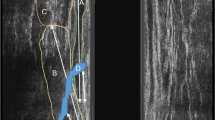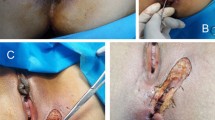Abstract
Background and aims
This study was undertaken to determine the incidence of and risk factors for anal incontinence after fistulotomy for intersphincteric fistula-in-ano. We also evaluated the role of anal manometry in preoperative assessment of intersphincteric fistula.
Materials and methods
A prospective, observational study was undertaken in 148 patients who underwent fistulotomy for intersphincteric fistula between January and December 2004. Functional results were assessed by standard questionnaire and anal manometry. Possible factors predicting postoperative incontinence were examined by univariate and multivariate regression analyses.
Results
The mean follow-up period was 12 months. Postoperative anal incontinence occurred in 30 patients (20.3%), i.e., soiling in 6, incontinence for flatus in 27, and incontinence for liquid stool in 4. Fistulotomy significantly decreased maximum resting pressure (85.9 ± 20.4 to 60.2 ± 18.4 mmHg, P < 0.0001) and length of the high pressure zone (3.92 ± 0.69 to 3.82 ± 0.77 cm, P = 0.035), but it did not affect voluntary contraction pressure (164.7 ± 85.2 to 160.3 ± 84.8 mmHg, P = 0.2792). Multivariate analysis showed low voluntary contraction pressure and multiple previous drainage surgeries to be independent risk factors for postoperative incontinence.
Conclusion
Fistulotomy produces a satisfactory outcome in terms of eradicating sepsis and preserving function in the vast majority of patients with intersphincteric fistula with intact sphincters. However, sphincter-preserving treatment may be advocated for patients with low preoperative voluntary contraction pressure or those who have undergone multiple drainage surgeries. Preoperative anal manometry is useful in determining the proper surgical procedure.
Similar content being viewed by others
References
Lunniss PJ, Kamm MA, Phillips RK (1994) Factors affecting continence after surgery for anal fistula. Br J Surg 81:1382–1385
van Tets WF, Kuijpers HC (1994) Continence disorders after anal fistulotomy. Dis Colon Rectum 37:1194–1197
Garcia-Aguilar J, Belmonte C, Wong WD, Goldberg SM, Madoff RD (1996) Anal fistula surgery. Factors associated with recurrence and incontinence. Dis Colon Rectum 39:723–729
Hamalainen KP, Sainio AP (1997) Cutting seton for anal fistulas: high risk of minor control defects. Dis Colon Rectum 40:1443–1446; discussion 1447
Ho YH, Tan M, Leong AF, Seow-Choen F (1998) Marsupialization of fistulotomy wounds improves healing: a randomized controlled trial. Br J Surg 85:105–107
Mylonakis E, Katsios C, Godevenos D, Nousias B, Kappas AM (2001) Quality of life of patients after surgical treatment of anal fistula; the role of anal manometry. Colorectal Dis 3:417–421
Chang SC, Lin JK (2003) Change in anal continence after surgery for intersphincteral anal fistula: a functional and manometric study. Int J Colorectal Dis 18:111–115
Garcia-Aguilar J, Davey CS, Le CT, Lowry AC, Rothenberger DA (2000) Patient satisfaction after surgical treatment for fistula-in-ano. Dis Colon Rectum 43:1206–1212
Cavanaugh M, Hyman N, Osler T (2002) Fecal incontinence severity index after fistulotomy: a predictor of quality of life. Dis Colon Rectum 45:349–353
Malouf AJ, Buchanan GN, Carapeti EA, Rao S, Guy RJ, Westcott E, Thomson JP, Cohen CR (2002) A prospective audit of fistula-in-ano at St. Mark’s hospital. Colorectal Dis 4:13–19
Aguilar PS, Plasencia G, Hardy TG Jr, Hartmann RF, Stewart WR (1985) Mucosal advancement in the treatment of anal fistula. Dis Colon Rectum 28:496–498
Athanasiadis S, Kohler A, Nafe M (1994) Treatment of high anal fistulae by primary occlusion of the internal ostium, drainage of the intersphincteric space, and mucosal advancement flap. Int J Colorectal Dis 9:153–157
Gustafsson UM, Graf W (2002) Excision of anal fistula with closure of the internal opening: functional and manometric results. Dis Colon Rectum 45:1672–1678
Koehler A, Risse-Schaaf A, Athanasiadis S (2004) Treatment for horseshoe fistulas-in-ano with primary closure of the internal fistula opening: a clinical and manometric study. Dis Colon Rectum 47:1874–1882
Kreis ME, Jehle EC, Ohlemann M, Becker HD, Starlinger MJ (1998) Functional results after transanal rectal advancement flap repair of trans-sphincteric fistula. Br J Surg 85:240–242
Lewis WG, Finan PJ, Holdsworth PJ, Sagar PM, Stephenson BM (1995) Clinical results and manometric studies after rectal flap advancement for infra-levator trans-sphincteric fistula-in-ano. Int J Colorectal Dis 10:189–192
Parks AG, Gordon PH, Hardcastle JD (1976) A classification of fistula-in-ano. Br J Surg 63:1–12
Jorge JM, Wexner SD (1993) Etiology and management of fecal incontinence. Dis Colon Rectum 36:77–97
Eckardt VF, Kanzler G (1993) How reliable is digital examination for the evaluation of anal sphincter tone? Int J Colorectal Dis 8:95–97
Cintron JR, Park JJ, Orsay CP, Pearl RK, Nelson RL, Sone JH, Song R, Abcarian H (2000) Repair of fistulas-in-ano using fibrin adhesive: long-term follow-up. Dis Colon Rectum 43:944–949; discussion 949–950
Park JJ, Cintron JR, Orsay CP, Pearl RK, Nelson RL, Sone J, Song R, Abcarian H (2000) Repair of chronic anorectal fistulae using commercial fibrin sealant. Arch Surg 135:166–169
Johnson EK, Gaw JU, Armstrong DN (2006) Efficacy of anal fistula plug vs. fibrin glue in closure of anorectal fistulas. Dis Colon Rectum 49:371–376
O’Connor L, Champagne BJ, Ferguson MA, Orangio GR, Schertzer ME, Armstrong DN (2006) Efficacy of anal fistula plug in closure of Crohn’s anorectal fistulas. Dis Colon Rectum 49:1569–1573
Author information
Authors and Affiliations
Corresponding author
Rights and permissions
About this article
Cite this article
Toyonaga, T., Matsushima, M., Kiriu, T. et al. Factors affecting continence after fistulotomy for intersphincteric fistula-in-ano. Int J Colorectal Dis 22, 1071–1075 (2007). https://doi.org/10.1007/s00384-007-0277-z
Accepted:
Published:
Issue Date:
DOI: https://doi.org/10.1007/s00384-007-0277-z




